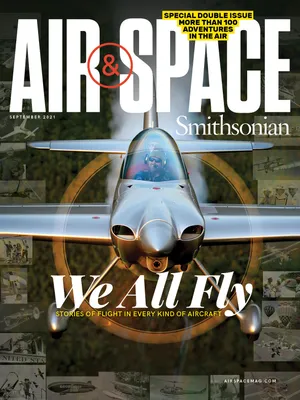Encounters With History
/https://tf-cmsv2-smithsonianmag-media.s3.amazonaws.com/filer/68/5d/685d81b5-ad44-4931-82e3-7a9381ebdbe2/04-2g_as2021_partofhistory-83kochersbergerwrightreplicaarnoldgreenwell_live.jpg)
Certain moments in any field of human activity rise above the ordinary and become burned in our memory. So it is with aviation. And some are lucky enough to witness these historic events, either as actors or bystanders.
The (Second) First Flight at Kitty Hawk
Winds 10 to 12 knots straight down the rail, temperature 15 degrees Centigrade and barometric pressure 29.92 inches. Not only was November 20, 2003 a perfect day at Kitty Hawk, North Carolina, but it marked the 50th anniversary of Scott Crossfield’s Mach 2 flight in the D-558-2 Skyrocket. When I boarded the reproduction Wright Flyer at Kitty Hawk, I had already flown the 1902 glider 70 times and practiced hundreds of flights in the 1903 machine using an accurate simulator based on wind tunnel test data. Guided by Crossfield, a team of four pilots was now ready to show the world the significance of Orville and Wilbur’s invention, 100 years later.
The view looking forward while listening to the rhythmic clatter of the engine and chains, and the swooping sound of the slow-turning propellers is burned into my memory. Now it’s 1903, and this is the first flight.
Moving down the rail and gaining speed, I singularly focused on keeping the wings level so as to not drag a wingtip. End of the track approaching, we should fly now, but still not flying. A little more up canard, and suddenly the nostalgia is replaced by a visceral fight to keep the unstable aircraft aloft. Full control deflections, stop-to-stop; we clearly don’t like each other, but I’m not giving up!
Skid landing in 98 feet, push the fuel cutoff and nothing broken. The distance does not exceed the Wrights’ first flight but proves powered flight. A mark in the sand is left. It was a giant leap for mankind in 1903. —Kevin Kochersberger, Blacksburg, VA
Welcome Back, Molly Brown
In March 1965, I was fortunate enough to be aboard the USS Intrepid aircraft carrier, the recovery vessel for Gemini 3. Gus Grissom had named the capsule “the Molly Brown,” as he did not want it to sink like his last (Mercury) capsule had done.
It was just a spectacular day, bright sunshine and beautiful blue skies. The splashdown was supposed to take place in the afternoon, so everyone on the ship was out looking skyward. I was in the Navy, attached to VAW-33 out of Quonset Point, Rhode Island, flying the AD-5W radar plane. We were like air traffic control towers in the sky. We could pick up planes out to 200 nautical miles and direct them back to the carrier.
On this day we were all just waiting for the Gemini capsule to splash down. When it came into Earth’s atmosphere we all saw the giant parachute open up, and the Gemini capsule swinging underneath it.
We sent over a helo with frogmen who jumped into the water and attached cables onto the “Molly Brown.” Then it was flown back to the flight deck of the Intrepid, while another helicopter brought back the two astronauts. Along with about 1,000 other sailors, I was so glad to see them down safely. —Jerry Ward, Ferndale, WA
A Trip Through Aviation History
Newly graduated from Fort Ord Army training post in California, in 1959, we bussed to Monterey airport, too late to catch the flight home. Three of us made a deal with a local pilot to fly us south in his Cessna 182. Cramming three bags in the rear and two soldiers in the back seat tipped the Cessna back, its tail not quite touching the ground. The pilot rushed me into the front seat, and the plane plopped back onto its nosewheel.
The flight to Santa Barbara was uneventful.
Two weeks later, I boarded a United DC-6B in Los Angeles for the night flight to Washington, D.C. We droned on through the night and in pre-dawn light landed...at Dallas Love Field. Allowed to climb down to the tarmac, we roamed around the plane while they worked on an engine. Never knew the problem, but we reboarded and flew on to Washington National Airport, arriving late for the connection to Baltimore Friendship field.
The ticket clerk took pity on this hot and tired 18-year-old soldier and offered a ride on their employee transport, duffel bag to follow later. So my last leg from Fort Ord to Fort Meade, Maryland, was aboard a DC-3/C-47, still in military configuration.
Four months later, my flight back to Los Angeles was in a Boeing 707 jet airliner.
For a teenage soldier, new to adult experience, a C-182, DC-6B, C-47, and B-707 as my introduction to travel was a saga never forgotten. —Tom Gauthier, Reno, NV
